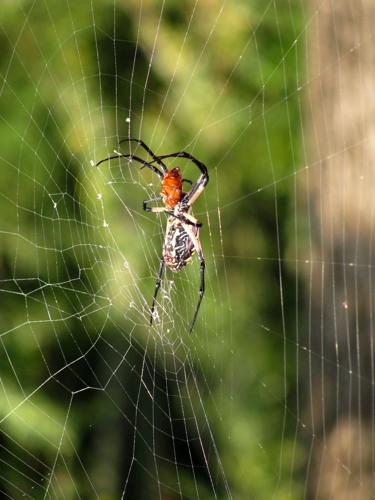Despite their creepy reputation, spiders are largely beneficial and help keep pests like plant-feeding insects under control.
I spent many a day as a child tossing assorted insects into garden spider webs. With few exceptions, spiders rarely bite and are not generally dangerous to people. Spiders are arachnids and are more closely related to mites and scorpions than to insects. Like insects and other arthropods, arachnids have a hard outer exoskeleton and jointed legs. Arachnids are distinguished by having eight legs attached to the cephalothorax, which is the front body region and bears the head and thorax fused together. Common outdoor spiders in Texas include jumping spiders, wolf spiders, crab spiders, trapdoor spiders and orbweavers.
Orbweaver spiders come in many shapes, colors and sizes. Most orbweavers make a vertically hanging orb web with concentric rings of silk — a “typical” spider web. Orb webs are marvels of architecture. The spider first establishes a bridge between two supports by drifting a thread of sticky silk on the wind until it catches the opposite support. After strengthening the bridge, the spider uses its own weight and the elastic properties of the silk to establish an initial silk triangle. Over many trips up and down the supports and the central triangle, the spider spins additional radii to build the web scaffold on which the orb will be spun. Then the spider spins the orbweaver’s trademark series of concentric, sticky rings. The spider uses up to seven different types of silk to build the web. The rings eventually trap flying prey. Many spiders tear down and rebuild their webs daily. Spiders that are active during the day do this work each morning. Some spiders eat the webs and recycle up to 90 percent of the material every day.
Some of the larger orbweavers, known as Argiope spiders, weave a zipperlike seam of heavy silk into the web called a stabilimenta. The precise function of the stabilimenta is not known. One idea is that it serves as a warning to birds to avoid the web, reducing the need to rebuild as often. Stabilimenta also reflect UV light, which may make the web more attractive to flying insects. Unlike jumping and wolf spiders, orbweavers do not see well. Instead, they use the web to get information from the environment and to locate insects that are caught in the web. Prey is usually quickly subdued by wrapping it in silk so the web is not destroyed. Orbweavers are harmless to people. The black and yellow garden spider, Argiope aurantia, is common in East Texas, and is the best known in the group. The female’s body is more than 1 inch long and its legs are even longer. Male Argiope are often less than one fourth the size of females and can be found in the same web with the female. Cricket and grasshopper-sized insects are often caught and eaten by these large spiders. I even once found a dead hummingbird in one’s web. Instead of scary movies, think of outdoor spiders as nature’s architectural insecticide.
Greg Grant is the Smith County horticulturist for the Texas A&M AgriLife Extension Service. He is author of “Texas Fruit and Vegetable Gardening” and co-author of “Heirloom Gardening in the South” and “The Rose Rustlers.” You can read his “Greg’s Ramblings” blog at arborgate.com, his “In Greg’s Garden” in each issue of Texas Gardener magazine (texasgardener.com) or follow him on Facebook at “Greg Grant Gardens.” More research-based gardening information from the Texas A&M AgriLife Extension Service can be found at aggie-horticulture.tamu.edu and plantanswers.com.




